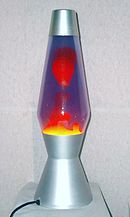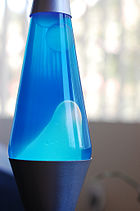- Lava lamp
-
A lava lamp (or Astro lamp) is a decorative novelty item that contains blobs of colored wax inside a glass vessel filled with clear liquid; the wax rises and falls as its density changes due to heating from a incandescent light bulb underneath the vessel. The appearance of the wax is suggestive of pāhoehoe lava, hence the name. The lamps are available in a variety of styles and colors of wax and liquid.
Contents
Operation
The lamp contains a standard incandescent bulb or halogen lamp which heats a tall (often tapered) glass bottle containing water and a transparent, translucent or opaque mix of mineral oil, paraffin wax and carbon tetrachloride.[1] The water and/or mineral oil can be colored with dyes. The density of common wax is much lower than that of water and would float on top under any temperature. However, the carbon tetrachloride is heavier than water (also nonflammable and miscible with wax), and is added to the wax to make its density at room temperature just little higher than that of the water. When heated, the wax mixture becomes less dense than the water because wax expands more than water when both are heated.[2] It also becomes fluid, and blobs of wax ascend to the top of the device where they cool (which increases their density relative to that of the water's) and then descend.[3] A metallic wire coil in the base of the bottle acts as a surface tension breaker to recombine the cooled blobs of wax after they descend.
The underlying mechanism is a form of Rayleigh–Taylor instability.
The bulb is normally 25 to 40 watts. It may take 45 to 60 minutes for the wax to warm up enough to freely form rising blobs (depending on the original temperature). It may take 2 to 3 hours if it has been in a cold room for a long time.
Once the wax is molten the lamp should not be shaken or knocked over or the two fluids may emulsify and the wax/blobs will remain cloudy rather than clear. Some recombination will occur as part of the normal cycle of the lava in the container but the only means to recombine all of wax is to turn off the lamp and wait a few hours. The wax will settle back down at the bottom, forming one blob once again. Severe cases can require many heat-cool cycles to clear.
History
Briton Edward Craven-Walker invented the lava lamp in 1960. His U.S. Patent 3,387,396 for "Display Device" was filed in 1965 and issued in 1968.[4] Craven-Walker's company was named Crestworth and was based in Poole, Dorset, in the United Kingdom. Craven-Walker named the lamp Astro and had variations such as the Astro Mini and the Astro Coach lantern. Craven-Walker presented it at a Brussels trade show in 1965, where the entrepreneur Adolph Wertheimer noticed it. Wertheimer and his business partner William M. Rubinstein bought the U.S. rights to manufacture and sell it as the Lava Lite via Lava Corporation or Lava Manufacturing Corporation. Wertheimer sold his shares to Hy Spector who took the product into production, manufacturing and marketing the Lava Lite in his Chicago factory at 1650 W. Irving Park Rd in the mid-60s. Rubinstein stayed on as a vice president. The lamps were a success throughout the 1960s and early 70s. Lava Corporation's name changed to Lava-Simplex-Scribe International in the early 1970s, and made instant-loading camera-film cartridges, as well as postage-stamp vending machines.
In the late seventies Spector sold Lava Simplex International to Micheal Eddie and Lawrence Haggerty of Haggerty Enterprises. Haggerty Enterprises continues to produce and sell the Lava Lamp in the US, using the name of Lavaglass. "Lava lamp" has been used as a generic term but Lavaworld has claimed violation of trademarks.[5]
In the 1990s, Craven-Walker, who had the rights to England and Western Europe, sold his rights to Cressida Granger, whose company, Mathmos, continues to make Lava Lamps and related products. Mathmos lamps are still made in the original factory in Poole.
Hazards
In 2004, Phillip Quinn, a 24-year-old of Kent, Washington, was killed during an attempt to heat up a lava lamp on his kitchen stove while closely observing it from only a few feet away. The heat from the stove built up pressure in the lamp until it exploded, spraying shards of glass with enough force to pierce his chest, with one shard piercing his heart and causing fatal injuries.[6] The circumstances of his death were later repeated and confirmed in a 2006 episode of the popular science television series MythBusters. The show also proved that even if shards of glass are not thrown with lethal velocity during such an attempt, the resulting spray of hot liquid from the lamp could easily cause severe burns to anyone nearby. The show also noted that the safety instructions clearly state that lava lamps should not be heated by any source other than the specifically rated bulbs and purpose-designed bases that are provided.[7] Homebrew lava lamp recipes can be found over internet, however some of them rely on combinations of highly flammable components like alcohol. Such lamps could represent a serious fire hazard in the case of rupture when heated over a light bulb.
See also
- Lavarand, random number generator that used lava lamps.
- Plasma globe
- Lava
Notes
- ^ U.S. Patent 3,570,156 p 2 line 30
- ^ U.S. Patent 3,570,156 p 1 lines 40 and 45
- ^ U.S. Patent 3,570,156 p 1 line 47
- ^ Patent 3570156
- ^ Legal Threats from Lavaworld. - Oozing Goo Lava Line
- ^ Lava Lamp Death at Snopes.com; AP story (via Fox News)
- ^ Mythbusters, Season 4, Episode 60: Earthquake Machine, first aired August 30, 2006.
External links
- Official site (UK)
- How Do Lava Lamps Work? (from The Straight Dope)
- How Liquid Motion Lamps Work (from howstuffworks.com)
- Basics of lava-lamp convection, by Balázs Gyüre and Imre M. Jánosi, Phys. Rev. E, 80, 046307 (2009).
Categories:- Light fixtures
- 1968 introductions
- Hippie movement
- Novelty items
Wikimedia Foundation. 2010.



